ISSN ONLINE(2319-8753)PRINT(2347-6710)
ISSN ONLINE(2319-8753)PRINT(2347-6710)
Dayalan J1, Buellah. M2
|
| Related article at Pubmed, Scholar Google |
Visit for more related articles at International Journal of Innovative Research in Science, Engineering and Technology
This project deals with objective of gaining knowledge in the field of material science / concrete technology which includes the study of internal curing of concrete. Applying water externally to the concrete is the conventional approach for curing. In practise conventional type of curing is difficult to perform as it shall need curing membrane and also large amount of water is wasted due to evaporation and runoff. Internal curing refers to the use of prewettedlight weight aggregate to provide sufficient moisture to the hydrating cement throughout the cross section of the concrete. These prewettedlight weight aggregates stores water in it and act as reservoirs which will be able to release the water whenever the concrete requires. Light weight aggregates such as expanded shale or clay is used for internal curing of concrete. The major advantages in internally cured concrete are, the concrete is light weight, free from shrinkage cracks, 3-dimensional curing, and limited use of water.In this study, expanded shale has been used in replacement for coarse aggregates in 10%, 15%, 20% and 25 %..This study also deals with testing of internally cured concrete to meet standards that it would ever need to face.
Keywords |
| Intrenal curing, Light weight aggregates, Expanded shale |
INTRODUCTION |
| Internal curing provides a set of water-filled reservoirs within the concrete that supply water on demand to the hydrating cement paste from the time of mixing (i.e., for reducing plastic shrinkage and maintaining workability) until the time when moisture equilibrium is achieved between the reservoirs and the surrounding cement paste for reducing dry shrinkage. Internal curing is achieved by replacing a percentage of coarse aggregate with light weight aggregate such as expanded shale.The light weight aggregate i.e., the shale is been heated at a temperature of 2000°F after which it is soaked in water for 24 hours and mixed with cement and fine aggregate. This mixture is been poured into the mould and external vibration was used to consolidate the specimen after casting immediately. The water stored in the lightweight aggregates is typically stored in pores that are larger than those in a hydrating cement paste. As a result the water moves from the light weight aggregate to the surrounding cement paste keeping the small pores saturated. The internal curing process utilizes cement more efficiently during the hydration process. Internal curing improves the workability and reduces the cracks due to plastic, drying and thermal shrinkage. The strength of the concrete is increased as the bond between the light weight aggregate and the hydrated cement becomes continuous due to decrease in permeability. |
II. LITERATURE SURVEY |
| Bentz.D.P. has studied that the substitution of light weight aggregate (LWA)sand for a portion of the normal weight sand to provide internal curing for a mortar is examined with respect to its influence on ITZ percolation and chloride ingress. Experimental measurements of chloride ion penetration depths are combined with computer modeling of the ITZ percolation and random walk diffusion simulations to determine the magnitude of the reduced diffusivity provided in a mortar with IC vs. one with only normal weight sand. In his study, for a mixture of sands that is 31% LWA and 69% normal weight sand by volume, the chloride ion diffusivity is estimated to be reduced by 25% or more, based on the measured penetration depths.Holm.T.A. has stated that for more than 80 years, shale’s, clays, and slates have been expanded in rotary kilns to produce structural grade LWA for use in concrete and masonry units. Millions of tons of structural grade LWA produced annually are used in structural concrete applications.Khokrin, N.K, discussed the unique physical characteristics of rotary kiln expanded slate lightweight aggregate for producing high performance and high strength lightweight concrete. The compressive strength, elastic modulus, splitting tensile strength, specific creep, and other properties of lightweight concrete are significantly affected by the structural properties of the lightweight aggregate used. Concrete production, transportation, pumping and placing are also affected.Hoff. G.C. described the use of near-saturated lightweight aggregate (LWA) as a replacement for a portion of the normal weight aggregate (NWA) in high-strength/high-performance concrete in order to mitigate or eliminate the self-desiccation and autogenous shrinkage that can occur which can further lead to early age cracking and long-term durability problems. The amount of LWA used to achieve beneficial internal curing is a function of the type of LWA, its size and amount, the degree of moisture preconditioning the LWA receives, the amount and type of binder(s) in the mixture, the waterbinder ratio at mixing, and the amount and duration of external moist curing provided to the concrete element.ArnonBentura et.al.studied that the concrete with saturated lightweight aggregate exhibited no autogenous shrinkage, whereas the normal-weight concrete with the same matrix exhibited large shrinkage. The study shows that the partial replacement of normal-weight aggregate by 25% by volume of saturated lightweight aggregate was very effective in eliminating the autogenous shrinkage and restrained stresses of the normal-weight concrete. It is noted that the internal supply of water from the saturated lightweight aggregate to the high-strength cement matrix caused continuous expansion, which may be related to continuous hydration. Ryan Henkensiefkenet. al has indicated that while internal curing may have been originally developed to reduce autogenous shrinkage and mitigate early-age cracking in high performance concretes, its application has far-reaching consequences for the performance of concrete throughout its lifetime By providing an on-demand source of extra water, internal curing can improve the slump retention, workability and finishability of fresh concrete and reduce deformations and cracking due to plastic, autogenous and drying shrinkage. |
III. MATERIALS |
A. Cement |
| The Ordinary Portland Cement of 53 grade conforming to IS: 12269-1987 is used. Thevariuos tests performed for the cement. The specific gravity of cement was found to be 3.157. The initial and final setting time for cements are found to be 29 minutes and 340 minutes. |
B. Coarse Aggregate |
| The fractions from 20 mm to 4.75 mm are used as coarse aggregate, conforming to IS: 383 is use. The properties of coarse aggregates such as specific gravity and water absorption are found to be 2.67 and 05.1% respectively. these values are within the range as given in IS 383-1970. |
C. Fine aggregate |
| The river sand conforming to the requirements of IS: 383 – 1970 is used as fine aggregate. The river sand is washed and screened to eliminate deleterious materials and over size particles. The properties of sand such as specific gravity and water absorption are found to be 2.52 and 1.14 % respectively. |
D. Expanded shale |
| Expanded Shale is a lightweight aggregate that is an ideal growing media for hydroponic or aquaponic systems. The shale is mined, crushed and fired under high temperatures in a rotary kiln, producing a clean, inert, porous, and light material.Expanded shale has improved physical properties such as reduced dead weight, high internal stability, high permeability, and high thermal resistance (Fig.1). The properties such as specific gravity and water absorption are found to be 1.64 and 10.03 % respectively. The properties of shale are given below in Table.1 |
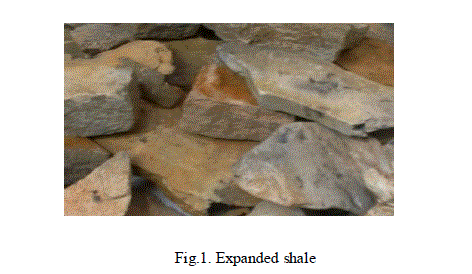 |
IV. PREPERATION OF SPECIMENS |
| The grade of concrete adopted for investigation is M 25. The free water-cement ratio required for the target mean strength of 33.75 N/mmïÿýïÿý is 0.43. This is lower than the maximum value of 0.65 prescribed for Mild exposure in IS: 456-1978.The mix design for the concrete blocks is prepared as per IS 10262-2009. The expanded shale is mixed in proportions of 10%, 15% , 20% and 25% by replacing the coarse aggregates. Stationary mixer is used to blend the raw materials together. As the dry raw materials are mixed well, water is added to the mixer. |
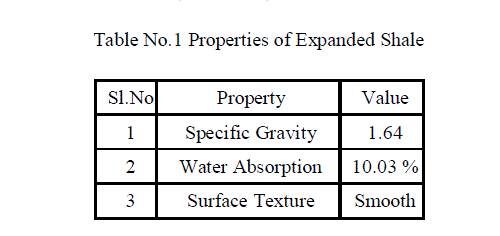 |
V. RESULTS AND DISCUSSIONS |
A.Workability Test |
| The concrete was tested for workability by slump Cone test by varying the percentage of expanded shale in coarse aggregates and values obtainted are within the permissible limit as per IS 456-2000 as shown below in Table.3 |
 |
B.Compression Test |
| The compressive strength of the cylinders was measured at 7, 21, 28 days and calculated as an average of three cylinders for each age as given in Table 4. Initially the internally cured concrete showed a lower compressive strength, but after 2 weeks, the strength of the concrete increased and exceeded the plain concrete. The compressive strength of the internally cured concrete was about 20% higher than the plain concrete because of the continuous hydration of the mixture at later ages, promoted by the extra water stored in the light weight aggregate. Though lightweight aggregate can be considered the weakest component in concrete the compressive strength of the internally cured concrete is higher than the plain concrete.The comparative study on the compressive strength of the concrete with respect to early strength and strength after 2 weeks (14 day and 28th day) compressive value is performed. From the experiment it is known that 10 % mix shows higher early strength. However, when compared to the control specimen all other the mixes with expanded shale doesn’t show any significant reduction or increase in strength.Thereby by designing the concrete for a compression for 20% of expanded shale help in reducing the cost for a certain value with increased performance and obtaining light weight concrete. |
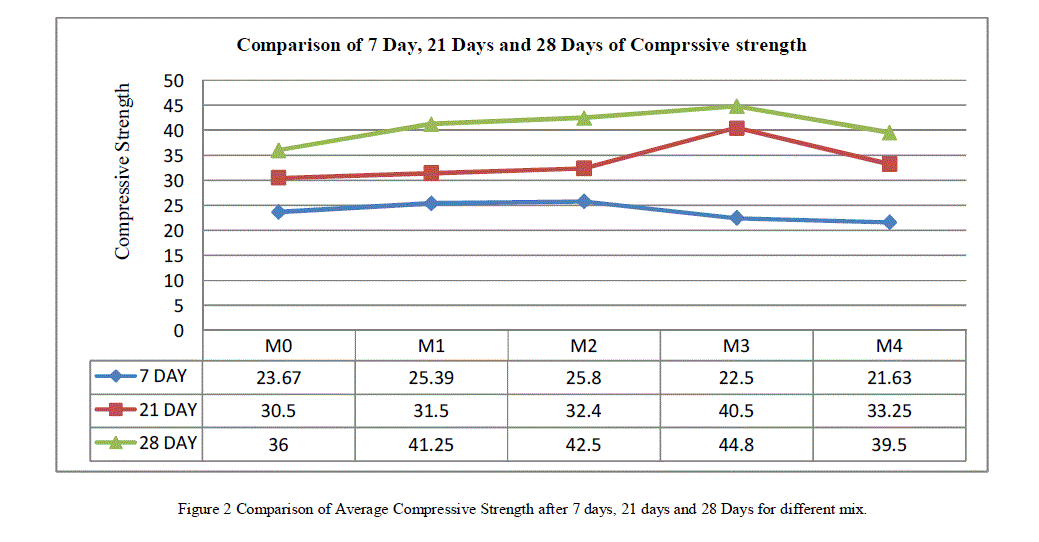 |
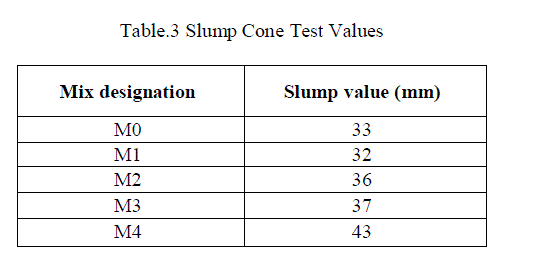 |
C.Durability test |
1.Rapid Chloride Penetration Test |
| The rapid chloride penetration test (RCPT) was performed in accordance with ASTM C 1202-12. A cylindrical specimen was prepared. Before testing the sample was vacuum saturated. During testing one surface of the sample was exposed to a sodium chloride solution (3% NaCl) and the other surface was exposed to a sodium hydroxide solution (0.3 M NaOH). A 60V external potential was applied and the resulting current at 15 minute intervals was recorded for a six hour period. The results from the rapid chloride penetrability and the temperature at the end of the 6 hours testing period, shows that internally cured mixture is passing lower charge than the plain concrete. |
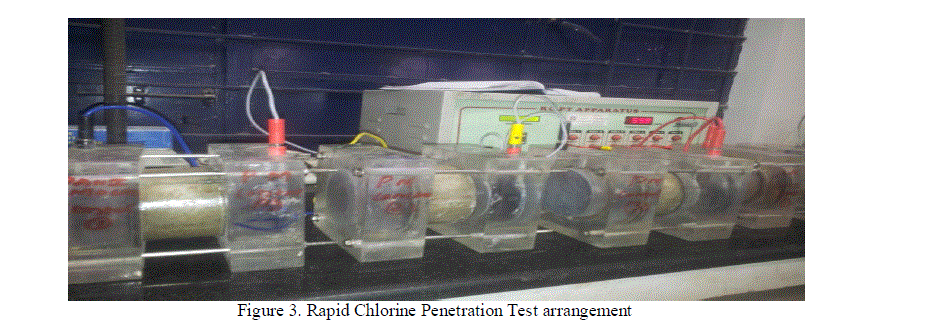 |
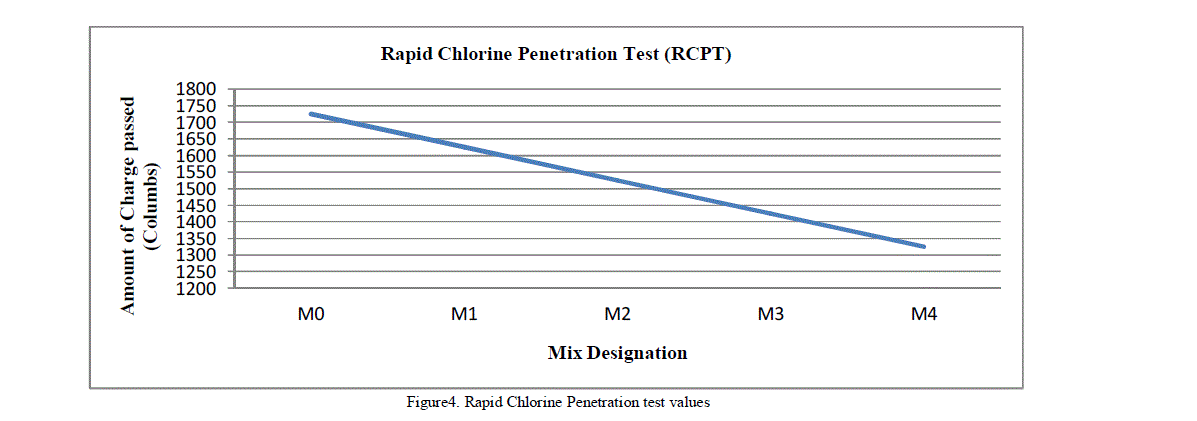 |
2.Acid Attack on Control Cube: |
| The weight of the Control mix cube initially before immersing in acid was found to be 8.23kg.It is then immersed in sulphuric acid for a period of 3 days after which it is taken out dried and then the weight of the cube after drying was found to be 7.05kg. |
3. Acid Attack on Cube with 10% Expanded Shale: |
| The weight of the cube with 10% Expanded Shale initially before immersing in acid was found to be 8.24kg.It is then immersed in sulphuric acid for a period of 3 days after which it is taken out dried and then weighed. The weight of the cube after acid attack was found to be 7.12kg.It is observed that the aggregates were exposed which is seen clearly in the figure. |
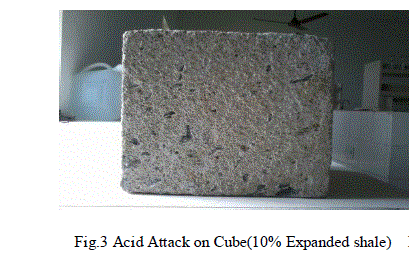 |
4.Acid Attack on Cube with 15% Expanded Shale: |
| The weight of the cube with 15% Expanded Shale initially before immersing in acid was found to be 8.19kg. The weight of the acid attacked cube was found to be 7.15 kg. It is observed that the resistance of the cube was comparatively better than the previously tested cubes. |
5.Acid Attack on Cube with 20% Expanded Shale: |
| The weight of the cube with 20% Expanded Shale initially before immersing in acid was found to be 8.17kg. The weight of the cube after acid attack was found to be 7.34kg.It is found that only few aggregates were exposed on the surface. |
6.Acid Attack on Cube with 25% Expanded Shale: |
| The weight of the cube 25% Expanded Shale initially before immersing in acid was found to be 8.12kg. The weight of the cube after acid attack was found to be 7.47kg.It is observed that the corrosion is very minimum and the amount of exposed aggregate is also very less. This is because of the increase in the amount of Expanded Shale added to the concrete mix. |
CONCLUSION |
| Based on the results it has been concluded that, |
| • The internally cured concrete is proved to be better than conventionally cured concrete by all means. |
| • The addition of Expanded Shale increases the degree of hydration, producing a denser microstructure leading to better curing. |
| Compressive strength results reveal that strength of internal cured specimens at 21 days and 28 days are greater but at the age of 7 days the strength is lower than conventionally cured specimens. |
| • The compressive strength for the internally cured concrete resulted in values 20% higher when compared to the plain concrete. |
| • The improved hydration also reduce micro cracking as a result of the lower shrinkage tendency of concrete with lightweight aggregate (Expanded Shale) used for internal curing. |
| • The rapid chloride migration test showed that the internally cured concrete had a lower diffusion coefficient than the plain concrete (15% and 50%, respectively). |
| • The rapid chloride penetrability of the internally cured concrete is lower than the plain concrete at all of the ages tested (approximately 55% at 180 days). |
| • The RCPT value for the control mix was found to be greater than the internal cured specimens. |
| • From the test results it is very clear that the use of lightweight aggregate in concrete as internal curing agent is beneficial for all the aspects investigated in this study. |
| The use of lightweight aggregate for internal curing of concrete is particularly beneficial as it reduces various shrinkage cracks. The compressive strength for the internally cured concrete resulted in values 20% higher when compared to the plain concrete. Enables a high relative humidity within the pore structure of the concrete which reduces internal drying and extends hydration process which thereby increases strength and durability of the concrete. |
References |
|